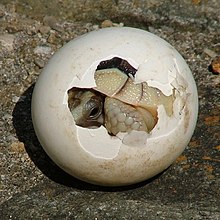
Back Amniota Afrikaans Amniota AN سلويات Arabic Амниоттар Bashkir Амніёты Byelorussian Амніёты BE-X-OLD Амниоти Bulgarian Amnioti BS Amniotes Catalan Blanatí Czech
| Amniota Temporal range: Carboniferous (Middle Mississippian) to Recent
| |
|---|---|

| |
| A baby tortoise leaves its amniotic egg. | |
| Scientific classification | |
| Domain: | Eukaryota |
| Kingdom: | Animalia |
| Phylum: | Chordata |
| Clade: | Reptiliomorpha |
| Clade: | Amniota Haeckel, 1866 |
| Living subgroups | |
|
See text | |
The amniotes are a taxonomic group of animals: all the tetrapods except the amphibians.
They are the land vertebrates which lay cleidoic eggs.[1]
Two super-groups make up the amniotes: the Synapsida (Pelycosaurs, Theriodonts and mammals) and the Sauropsida (all reptiles, including dinosaurs and birds).
The embryos of amniotes are either laid as eggs or develop in the female. These embyros are protected by several membranes, and have a much larger food supply than amphibian eggs.
The 'invention' of the cleidoic egg, and its embryonic membranes, is the main reason why the eggs of an amniote do not need to be laid in water.
Thus, as distinct from the amphibians, amniotes are truly terrestrial. Secondarily, many reptiles and mammals returned to water, and mammals bear the young live, as do some reptile groups. This evolutionary flexibility is much less common in amphibians.
- ↑ Mammalian embryos have the same structures.